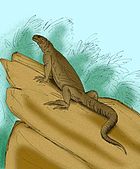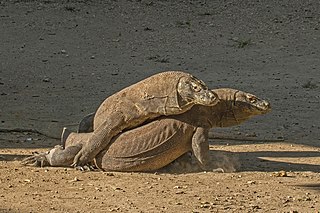
The Varanidae are a family of lizards in the superfamily Varanoidea and order Anguimorpha. The family, a group of carnivorous and frugivorous lizards, includes the living genus Varanus and a number of extinct genera more closely related to Varanus than to the earless monitor lizard (Lanthanotus). Varanus includes the Komodo dragon, crocodile monitor, savannah monitor, the goannas of Australia and Southeast Asia, and various other species with a similarly distinctive appearance. Their closest living relatives are the earless monitor lizard and chinese crocodile lizard. The oldest members of the family are known from the Late Cretaceous of Mongolia.

Monitor lizards are lizards in the genus Varanus, the only extant genus in the family Varanidae. They are native to Africa, Asia, and Oceania, and one species is also found in the Americas as an invasive species. About 80 species are recognized.

Megalania is an extinct species of giant monitor lizard, part of the megafaunal assemblage that inhabited Australia during the Pleistocene. It is the largest terrestrial lizard known to have existed, reaching an estimated length of 3.5 to 7 metres, and weighing between 97–1,940 kg (214–4,277 lb), but the fragmentary nature of known remains make estimates highly uncertain.
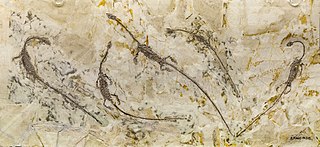
Hyphalosaurus is a genus of freshwater aquatic reptiles, belonging to the extinct order Choristodera. They lived during the early Cretaceous period, about 122 million years ago. The genus contains two species, H. lingyuanensis and H. baitaigouensis, both from the Yixian Formation of Liaoning Province, China. They are among the best-known animals from the Jehol Biota, with thousands of fossil specimens representing all growth stages in scientific and private collections.

Lufengosaurus is a genus of massospondylid dinosaur which lived during the Early Jurassic period in what is now southwestern China.

Shunosaurus, meaning "shu lizard", is a genus of sauropod dinosaur from Late Jurassic (Oxfordian) beds in Sichuan Province in China, from 161 to 157 Million years ago. The name derives from "Shu", an ancient name for the Sichuan province.
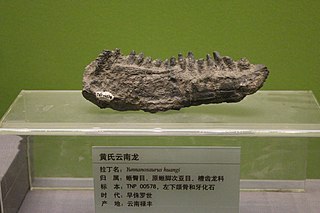
Yunnanosaurus is an extinct genus of sauropodomorph dinosaur that lived approximately 199 to 183 million years ago in what is now the Yunnan Province, in China, for which it was named. Yunnanosaurus was a large sized, moderately-built, ground-dwelling, quadrupedal herbivore, that could also walk bipedally, and ranged in size from 7 meters (23 feet) long and 2 m (6.5 ft) high to 4 m (13 ft) high in the largest species.

Lazarussuchus is an extinct genus of amphibious reptile, known from the Cenozoic of Europe. It is the youngest known member of Choristodera, an extinct order of aquatic reptiles that first appeared in the Middle Jurassic. Fossils have been found in Late Paleocene, Late Oligocene, Early Miocene and Late Miocene deposits in France, Germany, and the Czech Republic. Two species have been named: the type species L. inexpectatus ("unexpected") from the late Oligocene of France. and L. dvoraki from the early Miocene of the Czech Republic. It was not a large animal; the skull of L. inexpectatus was only about 4.53 centimeters long (1.78 in), with the total preserved body and tail length being just over 30 centimetres. A complete specimen of Lazarussuchus with preserved soft tissue was found from the Late Paleocene of France, but has not been assigned to a species.

Liaobatrachus is a genus of prehistoric frog, the first fossil specimen of which was recovered from the Yixian Formation of Liaoning Province, China. It was the first Mesozoic era frog ever found in China. The species Callobatrachus sanyanensis,Mesophryne beipiaoensis and Yizhoubatrachusmacilentus were classified as species of Liaobatrachus in one study, but this has been rejected by other authors. The genus has been considered a nomen dubium by some authors due to the poor preservation of the holotype specimen. Fossils were found in the Sihetun locality of the western part of Liaoning province, in the lower part of the Yixian Formation, and date to approximately 124.6 Ma. Another specimen was collected near Heitizigou, 25 kilometres (16 mi) south of Beipiao. The specimen has a snout–vent length of 69 millimetres (2.7 in). Liaobatrachus is considered to be the most basal member of Discoglossidae based on phylogenetic analysis.

Styporaphidia is a genus of snakefly, belonging to the extinct family Mesoraphidiidae, containing up to two species, the type species Styporaphidia magia and tentatively Styporaphidia? hispanica. The genus was named from the Greek stypos meaning "stem" or "stump" and Raphidia, the type genus for, and most often used as, a stem for generic names in the order Raphidioptera. The species name of S. magia is from the Greek word mageia meaning "magic" while the species name for S.? hispanica is from the Latin Hispania meaning "Spain" in reference to the type locality of the species.
Liushusaurus is an extinct genus of lizard described by Susan E. Evans and Yuan Wang in 2010. The genus has a single species, Liushusaurus acanthocaudata, and is known from eight fossils, several of which preserve soft tissue detail. The specimens were found in the Lower Cretaceous aged Yixian Formation of Northeast China. Liushusaurus is one of eight lizards that are known and have been named from the Yixian Formation, part of the diverse Jehol Biota ecosystem.

Yizhousaurus is a genus of basal sauropodiform dinosaurs which existed in what is now Lufeng Formation, Yunnan Province of southern China during the lower Jurassic period. Identified from a nearly complete and exquisitely preserved skeleton, it is the most complete basal sauropod currently known with intact skull. Although its name was revealed in a 2010 Geological Society of America abstract by Sankar Chatterjee, T. Wang, S.G. Pan, Z. Dong, X.C. Wu, and Paul Upchurch, it wasn't validly named and described until 2018. The type species is Yizhousaurus sunae.

Saniwa is an extinct genus of varanid lizard that lived during the Eocene epoch. It is known from well-preserved fossils found in the Bridger and Green River Formations of Wyoming, United States. The type species S. ensidens was described in 1870 as the first fossil lizard known from North America. A second species, S.orsmaelensis, is recognised from remains found in Europe. It is a close relative of Varanus, the genus that includes monitor lizards.

Hanosaurus is an extinct genus of marine reptiles that existed during the Triassic period in what is now China. The type species is Hanosaurus hupehensis. It was a small animal, with specimens measuring 79.4 cm (31.3 in) long in total body length, which likely fed on soft-bodied prey.

Shinisauria is a clade or evolutionary grouping of anguimorph lizards that includes the living Chinese crocodile lizard Shinisaurus and several of its closest extinct relatives. Shinisauria was named in 2008 by Jack Lee Conrad as a stem-based taxon to include all anguimorphs more closely related to Shinisaurus than to Anguis fragilis, Heloderma suspectum or Varanus varius. Several recent phylogenetic analyses of lizard evolutionary relationships place Shinisauria in a basal position within the clade Platynota, which also includes monitor lizards, helodermatids, and the extinct mosasaurs. Shinisaurians were once thought to be closely related to the genus Xenosaurus, but they are now considered distant relatives within Anguimorpha. The fossil record of shinisaurians extends back to the Early Cretaceous with Dalinghosaurus, which is from the Aptian aged Yixian Formation of China. Two other extinct shinisaurians are currently known: Bahndwivici from the Eocene of Wyoming and Merkurosaurus from the Late Oligocene of Germany and the Early Miocene of the Czech Republic. An indeterminate shinisaurian is known from an isolated tail found in the Eocene aged Messel pit in Germany.
Urtinotherium is an extinct genus of paracerathere mammals. It was a large animal that was closely related to Paraceratherium, and found in rocks dating from the Late Eocene to Early Oligocene period. The remains were first discovered in the Urtyn Obo region in Inner Mongolia, which the name Urtinotherium is based upon. Other referred specimens are from northern China.
Eohupehsuchus is a genus of extinct aquatic diapsid from the Upper Spathian of Hubei Province, located in Central China. The genus is monotypic and belongs to the order Hupehsuchia, whose members are characterized by toothless beak-like snouts, a row of dermal plates along their backs, and aquatic adaptations including paddle-shaped limbs and fusiform bodies with pachyostotic ribs.
Bashanosaurus is a genus of stegosaur dinosaur recovered from the Bajocian -aged Shaximiao Formation of Yunyang, Chongqing, China. The type species is Bashanosaurus primitivus. It is one of the basalmost stegosaurs and is also the oldest known stegosaur, supplanting the previous oldest known stegosaur, Adratiklit, which is roughly one million years younger.
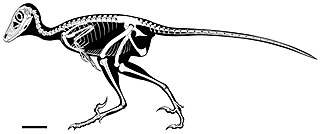
Daurlong is an extinct genus of dromaeosaurid dinosaur from the Early Cretaceous (Aptian) Longjiang Formation of China. The genus contains a single species, D. wangi, known from a nearly complete skeleton. Daurlong represents the first described occurrence of a preserved intestinal region in a theropod closely related to birds.

Luopingosaurus is an extinct genus of pachypleurosaurid sauropterygian from the Middle Triassic Guanling Formation of Yunnan Province, China. The genus contains a single species, L. imparilis, known from a well-preserved, nearly complete skeleton.

















